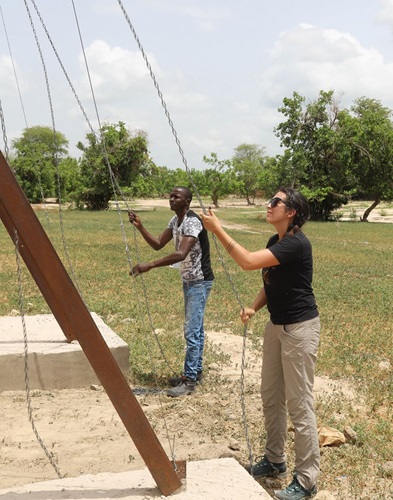A new Journal of the Royal Society Interface paper examines how raising houses off the ground can prevent mosquito entry.

Malaria is one of the leading causes of mortality in sub-Saharan Africa. Researchers from the UK, Denmark and The Gambia designed experimental houses to determine whether raising a house could reduce the number of mosquitoes from entering. Their study has recently been published in Journal of the Royal Society Interface. We spoke to Professor Steve W Lindsay and Ms Majo Carrasco-Tenezaca about their work.
1. What led you to look into this area?
The world’s most deadly assassin is Africa’s malaria mosquito: Anopheles gambiae. In 2019, the World Health Organisation estimated that malaria killed 386,000 people in sub-Saharan Africa, mainly children. Whilst we think of the home as a sanctuary, in Africa, around 80% of the malaria bites occur indoors at night. Preventing mosquitoes from getting indoors would be a simple way of protecting people from this often-lethal disease. In the 1970s researchers in The Gambia showed that most mosquitoes fly low to the ground, tracking plumes of carbon dioxide from human hosts. We wondered whether if we raised a house off the ground, malaria mosquitoes would struggle to find the occupants. We designed our experiment to find out.
2. Can you briefly tell us about your study and its findings?
We built four experimental houses in The Gambia, each of which could be raised to different heights above the ground. Each week, one hut was on the ground, whilst the bottom of the other huts were at 1m, 2m and 3m. Each night two men slept under separate mosquito nets in each hut and mosquitoes were collected indoors using a light trap. Each week the height of each house was changed, so that at the end of the 40 night experiment each hut had been at each of the four heights for 10 nights.
We found that increasing the height of a hut progressively reduced the number of mosquitoes entering the hut, such that at 3m above the ground, 84% fewer malaria mosquitoes entered the building compared with the hut on the ground.
Why was this? We think there are two reasons. First, malaria mosquitoes have evolved to find humans on the ground. Second, at higher heights, the carbon dioxide odour plumes coming out of the huts are rapidly dispersed by the wind, so mosquitoes find it more difficult to find a person to bite.

Image credit: Steve Lindsay
3. What was the most challenging part of your study?
The most challenging part was constructing the houses with great precision so that they could move easily up and down. Fortunately, the biologists in the team worked with expert architects and builders. The construction of the houses was also extremely physically demanding since the team were working at temperatures of over 40 °C in the shade.
4. What made you decide to publish in Journal of the Royal Society Interface?
For two reasons. First, we like the idea of working across the two disciplines of biology and the physical environment. The authors are all members of a Global Challenges Research Funded network that links experts on vector-borne diseases (like malaria) with those in the built environment (BOVA – Building Out Vector-borne diseases in sub-Saharan Africa https://www.bovanetwork.org/). Second, we especially liked the fact that the first presentation at the Royal Society was delivered by Sir Christopher Wren, an architect (and great scientist). If Sir Christopher were alive today, we hope he would be interested in our work.
5. Your study has real world applications. Are there any plans to develop prototypes based on the experimental huts?
Yes, indeed. We are keen to promote the use of two-storey buildings across sub-Saharan Africa. Jakob Knudsen and colleagues have designed an elevated house that will not only reduce the entry of malaria mosquitoes but will also keep the occupants cool at night, so they won’t be too hot to sleep under a bednet. Here’s a photo of one of the Star home houses in Tanzania built by Otis Sloan Brittain and Hannah Wood (photo by O’Brittain).

Image credit: Otis Sloan Brittain & Hannah Wood, Ingvartsen Architects.
6. What’s next for you and your research?
The Star home is designed not only to protect children against malaria, but also to protect them against the other two main killer diseases of children: respiratory infections and diarrhoeal diseases. Salum Mshamu is leading a trial to compare the rates of disease in children living in 110 Star homes and 440 traditional homes. The findings from our study in J. R. Soc. Interface suggests that our Star homes will protect children against malaria. Jakob Knudsen, Steve Lindsay, and John Bradley are working with Salum Mshamu, Lorenz von Seidlein and the field team in Tanzania on this important research.
A video of the experimental huts can be viewed from the following link: 10.6084/m9.figshare.14483475
For more innovative research, check out Journal of the Royal Society Interface.
Images:
1. Steve Lindsay
2. Steve Lindsay
3. Otis Sloan Brittain & Hannah Wood, Ingvartsen Architects



